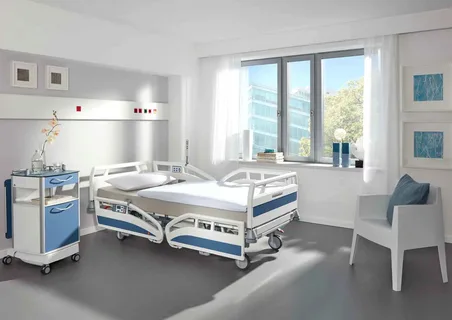Hospital Furniture Designed for Safety, Durability, and Comfort

When people think of hospitals, the first things that come to mind are doctors, nurses, and medical technology. However, one of the most vital yet often overlooked elements in healthcare facilities is hospital furniture. Whether it’s a patient bed, examination table, or waiting area chair, furniture plays a central role in ensuring safety, durability, and comfort for both patients and healthcare professionals. Modern hospitals now prioritize furniture that not only supports medical procedures but also contributes to the overall healing environment.
Why Safety Comes First
Safety is the cornerstone of hospital furniture design. In a medical setting, lives depend on reliable equipment and furniture that minimizes risks.
-
For Patients: Beds with side rails prevent falls, while adjustable heights make it easier for patients to get in and out safely. Wheelchairs and recliners with locking systems add an extra layer of protection.
-
For Staff: Ergonomic furniture reduces strain on nurses and doctors, helping them move patients or equipment more safely. Anti-slip surfaces and easy-to-clean designs also reduce risks of accidents and infections.
-
For Visitors: Chairs and benches in waiting areas are designed to be stable, sturdy, and safe for people of all ages.
Safe hospital furniture ensures that the healing process is not interrupted by avoidable accidents.
Durability – A Must for Healthcare Environments
Hospitals are high-traffic areas where furniture is used around the clock. Durability is not a luxury—it’s a necessity.
-
Heavy Use: Patient beds, trolleys, and wheelchairs are constantly in use and must withstand weight, movement, and repeated cleaning.
-
Material Strength: Stainless steel, medical-grade plastics, and engineered wood are often used because they can handle frequent disinfecting without damage.
-
Cost-Effectiveness: Durable furniture reduces long-term costs by minimizing the need for frequent replacements.
Durability ensures that furniture remains reliable, safe, and presentable over years of continuous use.
Comfort – Supporting Recovery and Well-Being
Comfort in hospital furniture directly affects patient recovery and satisfaction. Patients may spend days or weeks in hospitals, and comfort becomes essential for their physical and emotional well-being.
-
Patient Beds: Adjustable mattresses, backrests, and leg supports reduce discomfort and allow patients to rest in suitable positions.
-
Waiting Area Furniture: Comfortable sofas and chairs ease stress for family members and visitors.
-
Staff Seating: Ergonomic chairs and workstations help doctors and nurses perform long shifts without fatigue.
Comfort is not just about luxury—it plays a therapeutic role in creating a healing atmosphere.
Examples of Safe, Durable, and Comfortable Hospital Furniture
-
Smart Adjustable Beds: Equipped with electric controls, pressure-relief mattresses, and safety rails.
-
Examination Tables: Designed with cushioned tops for patient comfort and strong frames for stability.
-
Medical Trolleys: Built with sturdy wheels and anti-slip handles to ensure safe transport of equipment.
-
Recliner Chairs: Perfect for dialysis or chemotherapy patients, offering long-term comfort.
-
Modular Storage Units: Durable cabinets designed for easy cleaning and frequent use.
Each piece is carefully engineered to meet safety standards while ensuring long-lasting use and maximum comfort.
Benefits of Combining Safety, Durability, and Comfort
For Patients
-
Reduced stress and faster healing in a comfortable environment.
-
Enhanced safety reduces the chances of falls or accidents.
-
Long-term comfort during treatments and recovery.
For Healthcare Providers
-
Safe, ergonomic furniture reduces strain during patient handling.
-
Durable furniture supports efficient workflows without frequent breakdowns.
-
Comfortable designs improve staff morale and productivity.
For Hospitals
-
Investment in durable furniture saves costs on replacements and repairs.
-
A safer, more comfortable environment builds trust with patients and families.
-
Modern, well-maintained furniture enhances hospital's reputation.
Modern Trends in Hospital Furniture
Hospitals across Pakistan, especially in cities like Lahore, Karachi, and Islamabad, are adopting new trends in hospital furniture:
-
Smart Technology Integration: Beds and chairs with digital monitoring features.
-
Eco-Friendly Materials: Sustainable designs that reduce environmental impact.
-
Custom Furniture Solutions: Tailored designs for ICUs, OPDs, and patient rooms.
-
Aesthetic Enhancements: Furniture that combines professional looks with calming designs.
These trends reflect the growing importance of hospital furniture in shaping the patient experience.
Choosing the Right Hospital Furniture Supplier
Selecting the right supplier is as important as choosing the furniture itself. Hospitals should look for suppliers who:
-
Offer furniture built with medical-grade materials.
-
Provide warranty and after-sales service.
-
Customize furniture according to hospital needs.
-
Meet international safety and quality standards.
A trusted supplier ensures hospitals get value for money while creating safe, durable, and comfortable environments.
Conclusion
Hospital furniture is more than just a necessity—it is an essential part of the healthcare journey. Furniture designed with safety, durability, and comfort in mind creates a space where patients can heal, staff can work efficiently, and hospitals can maintain their reputation for quality care.
In today’s fast-evolving medical world, hospitals cannot afford to compromise on these three pillars. By investing in high-quality hospital furniture, healthcare institutions not only improve patient outcomes but also set themselves apart as leaders in compassionate, professional care.






